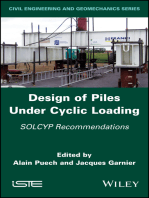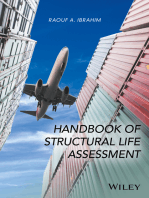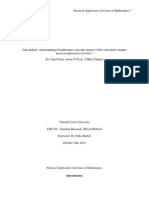0 ratings0% found this document useful (0 votes)
174 viewsNon-Linear Static (Pushover) Analysis
Non-Linear Static (Pushover) Analysis
Uploaded by
Anonymous 4emDZITjoNon-Linear Static (Pushover) Analysis allows users to model the nonlinear behavior of structures subjected to lateral loads. It can analyze structures using multiple pushover load cases, each with a different load distribution. The analysis yields hinge formations, member forces, base shear-displacement curves, and capacity spectra that provide insights into the structure's failure mechanisms and capacity. The general workflow involves creating a model, defining loads, hinges, and pushover cases, running the analysis, and reviewing the results.
Copyright:
© All Rights Reserved
Available Formats
Download as DOCX, PDF, TXT or read online from Scribd
Non-Linear Static (Pushover) Analysis
Non-Linear Static (Pushover) Analysis
Uploaded by
Anonymous 4emDZITjo0 ratings0% found this document useful (0 votes)
174 views3 pagesNon-Linear Static (Pushover) Analysis allows users to model the nonlinear behavior of structures subjected to lateral loads. It can analyze structures using multiple pushover load cases, each with a different load distribution. The analysis yields hinge formations, member forces, base shear-displacement curves, and capacity spectra that provide insights into the structure's failure mechanisms and capacity. The general workflow involves creating a model, defining loads, hinges, and pushover cases, running the analysis, and reviewing the results.
Original Description:
open it
Copyright
© © All Rights Reserved
Available Formats
DOCX, PDF, TXT or read online from Scribd
Share this document
Did you find this document useful?
Is this content inappropriate?
Non-Linear Static (Pushover) Analysis allows users to model the nonlinear behavior of structures subjected to lateral loads. It can analyze structures using multiple pushover load cases, each with a different load distribution. The analysis yields hinge formations, member forces, base shear-displacement curves, and capacity spectra that provide insights into the structure's failure mechanisms and capacity. The general workflow involves creating a model, defining loads, hinges, and pushover cases, running the analysis, and reviewing the results.
Copyright:
© All Rights Reserved
Available Formats
Download as DOCX, PDF, TXT or read online from Scribd
Download as docx, pdf, or txt
0 ratings0% found this document useful (0 votes)
174 views3 pagesNon-Linear Static (Pushover) Analysis
Non-Linear Static (Pushover) Analysis
Uploaded by
Anonymous 4emDZITjoNon-Linear Static (Pushover) Analysis allows users to model the nonlinear behavior of structures subjected to lateral loads. It can analyze structures using multiple pushover load cases, each with a different load distribution. The analysis yields hinge formations, member forces, base shear-displacement curves, and capacity spectra that provide insights into the structure's failure mechanisms and capacity. The general workflow involves creating a model, defining loads, hinges, and pushover cases, running the analysis, and reviewing the results.
Copyright:
© All Rights Reserved
Available Formats
Download as DOCX, PDF, TXT or read online from Scribd
Download as docx, pdf, or txt
You are on page 1of 3
Non-Linear Static (Pushover) Analysis
Nonlinear static pushover analysis capabilities are provided in the nonlinear
version of SAP2000 only. The nonlinear behavior occurs in discrete user-defined
hinges. Currently, hinges can be introduced into frame objects only and assigned at
any location along the frame object. Uncoupled moment, torsion, axial force and
shear hinges are available. There is also a coupled P-M2-M3 hinge that yields
based on the interaction of axial force and bending moments at the hinge location.
More than one type of hinge can exist at the same location; for example, both an
M3 (moment) and a V2 (shear) hinge may be assigned to the same end of a frame
object. For more information about hinges, see Hinge Properties.
A pushover analysis can consist of more than one pushover load case. Each
pushover load case can have a different distribution of load on the structure. For
example, a typical pushover analysis might consist of three pushover load cases.
The first would apply gravity load to the structure, the second would apply one
distribution of lateral load over the height of the structure, and the third would
apply another distribution of lateral load over the height of the structure. There are
four different methods of describing the distribution of load on the structure for a
pushover load case:
1. A uniform acceleration can be automatically applied. In that case, the lateral
force automatically applied at each node is proportional to the mass tributary
to that node.
2. A lateral force that is proportional to the product of a specified mode shape
times its circular frequency squared (2) times the mass tributary to a node
can be automatically applied at each node. The user may specify the mode
shape to be used in that instance.
3. An arbitrary static load pattern may be defined.
4. Any of the methods described in 1, 2 and 3 can be combined.
Several types of output can be obtained from the nonlinear static pushover
analysis:
1. Base shear versus displacement at a specified control joint can be plotted.
2. Base shear versus displacement at a specified control joint can be plotted in
the ADRS format where the vertical axis is spectral acceleration and the
horizontal axis is spectral displacement. The demand spectra can be
superimposed on that plot.
3. The sequence of hinge formation and the color-coded state of each hinge can
be viewed graphically, on a step-by-step basis, for each step of the pushover.
4. The member forces can be viewed graphically, on a step-by-step basis, for
each step of the analysis.
5. Tabulated values of base shear versus displacement at each point along the
pushover curve, along with tabulations of the number of hinges beyond
certain control points on their hinge property force-displacement curve can
be viewed on the screen, printed, or saved to a file.
6. Tabulated values of the capacity spectrum (ADRS capacity and demand
curves), the effective period and the effective damping can be viewed on the
screen, printed, or saved to a file.
The following general sequence of steps is involved in a nonlinear static pushover
analysis:
1. Create a model.
2. Define arbitrary static load cases, if needed, for use in the pushover analysis.
Note that the program also has built-in capability to define the distribution
of lateral load over the height of the structure based on both uniform
acceleration and mode shapes.
3. Define the pushover load cases.
4. Define hinge properties.
5. Assign hinge properties to frame elements.
6. Run the pushover analysis by selecting a static nonlinear load case on
the Set Load Cases to Run form. The load case will be available only if there
is at least one frame object with a hinge property assigned to it, and there is
at least one pushover load case defined. If frame objects are specified to be
designed by the program, this design automatically will be performed before
the pushover analysis routine begins.
7. Review the pushover results.
8. If necessary, revise the model and repeat steps 2 through 7.
You might also like
- 01 - Force Method of Analysis General ProcedureDocument2 pages01 - Force Method of Analysis General ProcedureE Cos Lopez100% (1)
- Development Wind Code in Sri LankaDocument9 pagesDevelopment Wind Code in Sri LankaArzath SajeerNo ratings yet
- Chapter 3 - Global Analysis EquationsDocument54 pagesChapter 3 - Global Analysis EquationsCarl Chester RagudoNo ratings yet
- Static Linear and Non Linear (Pushover) Analysis of RC Building On Sloping Grounds On Medium Soils in Different ZonesDocument10 pagesStatic Linear and Non Linear (Pushover) Analysis of RC Building On Sloping Grounds On Medium Soils in Different ZonesIAEME PublicationNo ratings yet
- Perform-3d-V5 0 0Document15 pagesPerform-3d-V5 0 0Darley MauricioNo ratings yet
- Effects of Soil-Structure Interaction On Base-IsolationDocument19 pagesEffects of Soil-Structure Interaction On Base-Isolation305 SREEKANTH REDDYNo ratings yet
- Effect of Shear Wall Location in Buildings Subjected To Seismic LoadsDocument11 pagesEffect of Shear Wall Location in Buildings Subjected To Seismic LoadsSujtth MathewNo ratings yet
- A Comparative Study of Retrofitting of RC Building Using Steel Bracing and Infill WallsDocument7 pagesA Comparative Study of Retrofitting of RC Building Using Steel Bracing and Infill WallsAravindanNo ratings yet
- Impacts From Three-Dimensional Effect On The Wall Deflection Induced by A Deep Excavation in Kaohsiung, TaiwanDocument6 pagesImpacts From Three-Dimensional Effect On The Wall Deflection Induced by A Deep Excavation in Kaohsiung, TaiwanvttrlcNo ratings yet
- NIT Trichy Presentation DipenduDocument74 pagesNIT Trichy Presentation Dipenduepe civil100% (1)
- About Pushover Analysis and SAP 2000 MethodDocument12 pagesAbout Pushover Analysis and SAP 2000 MethodHanush Anand100% (2)
- Static and Dynamic Analysis of Shear Wall Subjected To Lateral LoadsDocument7 pagesStatic and Dynamic Analysis of Shear Wall Subjected To Lateral LoadsVivek PatvaNo ratings yet
- Concepts of Plastic Hinging and Pushover Analysis With Midas CivilDocument53 pagesConcepts of Plastic Hinging and Pushover Analysis With Midas CivilArkarNo ratings yet
- Linear and Nonlinear Dynamic Analysis of Masonry I PDFDocument16 pagesLinear and Nonlinear Dynamic Analysis of Masonry I PDFsaurav rajNo ratings yet
- Precast Frame - 5 Floor DiaphragmsDocument15 pagesPrecast Frame - 5 Floor DiaphragmsWahid OmarNo ratings yet
- Fundamental Time Period of RC Setback BuildingsDocument35 pagesFundamental Time Period of RC Setback BuildingsMohamed MamdohNo ratings yet
- Torsional IrregularityDocument29 pagesTorsional Irregularitygaurav jagtap0% (1)
- Analysis of G+30 Highrise Buildings by Using Etabs For Various Frame Sections in ZoneIV and ZoneV PDFDocument15 pagesAnalysis of G+30 Highrise Buildings by Using Etabs For Various Frame Sections in ZoneIV and ZoneV PDFK.ANISHNo ratings yet
- Seismic Analysis of Regular and Irregular Multistorey Buildngs Using Staad - ProDocument8 pagesSeismic Analysis of Regular and Irregular Multistorey Buildngs Using Staad - ProInternational Journal of Innovative Science and Research TechnologyNo ratings yet
- Nonlinear Analysis Methods For Reinforced Concrete Buildings With Shear WallsDocument8 pagesNonlinear Analysis Methods For Reinforced Concrete Buildings With Shear Wallsakif-benzer-6764No ratings yet
- Pushover AnalysisDocument20 pagesPushover AnalysisMarcelo Quisbert100% (2)
- Pasticier - Nonlinear - Seismic - Analysis of A Masonry Building in SAP2000Document19 pagesPasticier - Nonlinear - Seismic - Analysis of A Masonry Building in SAP2000Marcos Di SierviNo ratings yet
- Displacement Based Seismic Design Chapter 01 (Points)Document14 pagesDisplacement Based Seismic Design Chapter 01 (Points)MuhammadNomanKNo ratings yet
- A Review On Applications of Tuned Liquid Dampers in Vibration ControlDocument17 pagesA Review On Applications of Tuned Liquid Dampers in Vibration ControlBharadwaj NandaNo ratings yet
- Nonlinear Dynamic Analysis of Reticulated Space Truss StructuresDocument39 pagesNonlinear Dynamic Analysis of Reticulated Space Truss StructuresArjun RajaNo ratings yet
- Uls Design of Conrete StructuresDocument20 pagesUls Design of Conrete StructuresBhushanRajNo ratings yet
- Pile Cap Design - Structural GuideDocument9 pagesPile Cap Design - Structural Guidedhan singhNo ratings yet
- Lecture 2 Theory of Elasticity and PlasticityDocument12 pagesLecture 2 Theory of Elasticity and PlasticityVinayak UntwaleNo ratings yet
- Etabs Examples PDFDocument2 pagesEtabs Examples PDFSarahNo ratings yet
- Advanced Structural AnalysisDocument3 pagesAdvanced Structural AnalysisAgam Reddy MNo ratings yet
- Arce211structures 1 - +++Document143 pagesArce211structures 1 - +++Vijay KumarNo ratings yet
- Problem 1 025Document6 pagesProblem 1 025Oscar SanchezNo ratings yet
- Direct Displacement-Based DesignDocument21 pagesDirect Displacement-Based DesignAmal OmarNo ratings yet
- Lateral Torsional Buckling Behaviour of Steel BeamsDocument19 pagesLateral Torsional Buckling Behaviour of Steel Beamssantosh bharathyNo ratings yet
- Material Course Ch7&8Document22 pagesMaterial Course Ch7&8hemant_durgawaleNo ratings yet
- Chapter6 StiffnessMethodDocument11 pagesChapter6 StiffnessMethodkaranfilhasanNo ratings yet
- Irregularities in BuildingDocument5 pagesIrregularities in Buildingshibajeesutar100% (1)
- A Seismic Structural Configurations Sudhir K Jian C V R Murty and Durgesh C Rai 2012Document89 pagesA Seismic Structural Configurations Sudhir K Jian C V R Murty and Durgesh C Rai 2012sabareesan09No ratings yet
- Seismic Analysis of Structures IIIDocument152 pagesSeismic Analysis of Structures IIINiroj MaharjanNo ratings yet
- P Delta AnalysisDocument3 pagesP Delta AnalysisSameer BelimNo ratings yet
- Analysis of Behaviour of Multistorey RCC Structure With Different Types of Bracing System (By Using Software)Document9 pagesAnalysis of Behaviour of Multistorey RCC Structure With Different Types of Bracing System (By Using Software)IJRASETPublicationsNo ratings yet
- Effective Use of Transfer PlatesDocument12 pagesEffective Use of Transfer PlatesMohamedNo ratings yet
- Behavior of A Multistoried Building With and Without Infill Walls Under Seismic Forces Using STAAD - PRODocument11 pagesBehavior of A Multistoried Building With and Without Infill Walls Under Seismic Forces Using STAAD - PROIJSTENo ratings yet
- EarthquakeDocument32 pagesEarthquakeRica Jewel VistaNo ratings yet
- Wide Frame AnalogyDocument13 pagesWide Frame AnalogyFikri AnwarNo ratings yet
- Shear Design of Reinforced Concrete Beams, Slabs and WallsDocument10 pagesShear Design of Reinforced Concrete Beams, Slabs and WallsGopu RNo ratings yet
- Transfer PlateDocument10 pagesTransfer PlateAlex Ferrari100% (1)
- Structural Element Approaches For Soil-Structure InteractionDocument64 pagesStructural Element Approaches For Soil-Structure Interactiondonly1100% (1)
- Introduction - UBC - NEHRP - Comparison of Seismic Provision Fo 1997 UBC To 1997 NEHRPDocument25 pagesIntroduction - UBC - NEHRP - Comparison of Seismic Provision Fo 1997 UBC To 1997 NEHRPeplim60No ratings yet
- Effect of Soft Story On Structural Response of High Rise BuildingsDocument14 pagesEffect of Soft Story On Structural Response of High Rise Buildingsprakashcg123No ratings yet
- 1 - Fiber Modeling ApproachDocument63 pages1 - Fiber Modeling ApproachDuy PhướcNo ratings yet
- Lateral Response of Piled Raft Under Vertical LoadDocument9 pagesLateral Response of Piled Raft Under Vertical LoadManojit SamantaNo ratings yet
- A Catalogue of Details on Pre-Contract Schedules: Surgical Eye Centre of Excellence - KathFrom EverandA Catalogue of Details on Pre-Contract Schedules: Surgical Eye Centre of Excellence - KathNo ratings yet
- Introduction to the Explicit Finite Element Method for Nonlinear Transient DynamicsFrom EverandIntroduction to the Explicit Finite Element Method for Nonlinear Transient DynamicsNo ratings yet
- Design of Piles Under Cyclic Loading: SOLCYP RecommendationsFrom EverandDesign of Piles Under Cyclic Loading: SOLCYP RecommendationsAlain PuechNo ratings yet
- VUP DesignDocument3 pagesVUP DesignAnonymous 4emDZITjoNo ratings yet
- VUP, SVUP & LVUP (Pkgs. 1,2&3)Document16 pagesVUP, SVUP & LVUP (Pkgs. 1,2&3)Anonymous 4emDZITjoNo ratings yet
- ReferDocument2 pagesReferAnonymous 4emDZITjoNo ratings yet
- SP 73 PDFDocument11 pagesSP 73 PDFAnonymous 4emDZITjoNo ratings yet
- Transportation EngineeringadDocument100 pagesTransportation EngineeringadAnonymous 4emDZITjoNo ratings yet
- AI and Machine Learning - 27Document1 pageAI and Machine Learning - 27Proyecto CementoNo ratings yet
- 9 (2019) (Scopus)Document14 pages9 (2019) (Scopus)Ismacahyadi Mohamed JaisNo ratings yet
- Practical Application Activities in MathematicsDocument46 pagesPractical Application Activities in Mathematicsjbottia1100% (1)
- Ai Fitness Trainer Using Human Pose Estimation IJERTCONV11IS08017Document8 pagesAi Fitness Trainer Using Human Pose Estimation IJERTCONV11IS08017Sparsh SharmaNo ratings yet
- 32 Riotronic XS Detonator Eng N051820Document2 pages32 Riotronic XS Detonator Eng N051820Pedro Ramos PAchecoNo ratings yet
- Rewrites Transformations B2 ESO Bach ENGLISH EOIDocument9 pagesRewrites Transformations B2 ESO Bach ENGLISH EOIPatricia Navarro CarreraNo ratings yet
- Writing SkillDocument20 pagesWriting SkillAgoes Kong Ming100% (4)
- Circular Relation of Acts and Character - For LMSDocument7 pagesCircular Relation of Acts and Character - For LMSJames CancinoNo ratings yet
- Title: Cover-Fr Under No. 75892 NDS01Document7 pagesTitle: Cover-Fr Under No. 75892 NDS01Diego Camargo100% (1)
- Numerical, Algebraic. AP Edition. Fourth Edition. Pearson.2012Document3 pagesNumerical, Algebraic. AP Edition. Fourth Edition. Pearson.2012engrroyNo ratings yet
- Joint Hearing, 111TH Congress - Morning Discussion: Roundtable On Minorities in FranceDocument36 pagesJoint Hearing, 111TH Congress - Morning Discussion: Roundtable On Minorities in FranceScribd Government DocsNo ratings yet
- Naemt Violence Report Web 10-02-2019Document20 pagesNaemt Violence Report Web 10-02-2019Lexipol_Media_GroupNo ratings yet
- WCO Implementation Plan 2024 2025Document14 pagesWCO Implementation Plan 2024 2025K60 NGUYỄN THỊ HƯƠNG QUỲNHNo ratings yet
- SABIK MARINE Datasheet VLB-44X 2020Document2 pagesSABIK MARINE Datasheet VLB-44X 2020SUBHASHIS SAHOONo ratings yet
- Manufacturing Processes (Machining Processes & Machine Tools) (Beng) (Handout)Document82 pagesManufacturing Processes (Machining Processes & Machine Tools) (Beng) (Handout)bananaNo ratings yet
- Lesson 70Document4 pagesLesson 70malarNo ratings yet
- Use of Air Decks To Reduce Subdrillings in Escondida MineDocument8 pagesUse of Air Decks To Reduce Subdrillings in Escondida MineRoberto NoriegaNo ratings yet
- PSC-A32MN User ManualDocument56 pagesPSC-A32MN User Manualnaveed khanNo ratings yet
- Rational Trust Modeling: Mehrdad NojoumianDocument12 pagesRational Trust Modeling: Mehrdad NojoumianMichael YuNo ratings yet
- MP OB Session 3Document31 pagesMP OB Session 3Shubham GoyalNo ratings yet
- Emulator Users GuideDocument182 pagesEmulator Users GuideMarco RumbauaNo ratings yet
- Wravor Catalog enDocument28 pagesWravor Catalog enuripssgmailNo ratings yet
- Centrifugal PumpDocument14 pagesCentrifugal PumpVivek Blueblood KannaNo ratings yet
- Organization Behaviour Understanding Organizations: Dr. Sumi JhaDocument32 pagesOrganization Behaviour Understanding Organizations: Dr. Sumi JhakartikNo ratings yet
- Paper MillDocument20 pagesPaper MillAjanta Bearing100% (1)
- Recreational Games Tug of WarDocument2 pagesRecreational Games Tug of WarDomz DomanicoNo ratings yet
- DLP English q2 w2 d1Document3 pagesDLP English q2 w2 d1Rosevyl Azas CadayNo ratings yet
- 2020 Blue BookDocument64 pages2020 Blue BookJeoffree DevezaNo ratings yet
- GEM 2024-18-03 Web Page Per Page WebDocument148 pagesGEM 2024-18-03 Web Page Per Page WebNiraj HNo ratings yet
- Smart Control and Automation NetworkDocument7 pagesSmart Control and Automation NetworkmewmewNo ratings yet






























































































